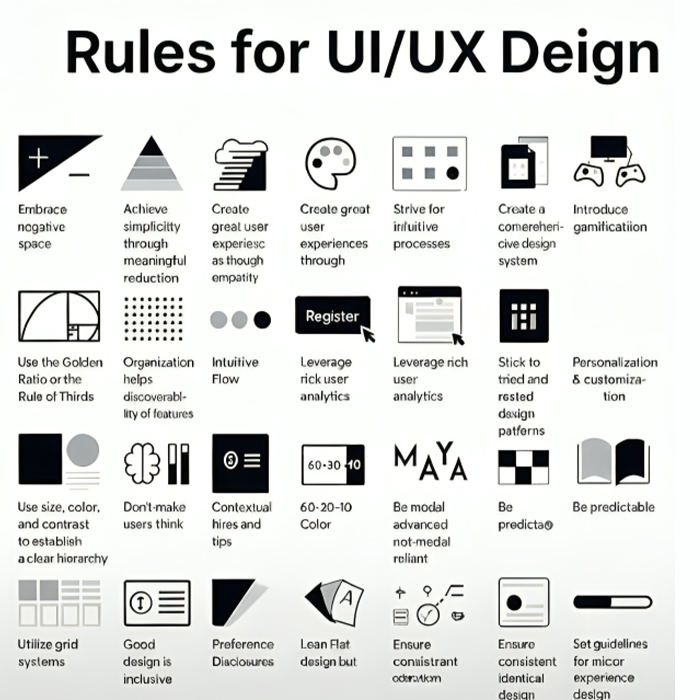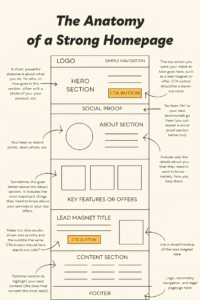
Design is about people and the choices they make. In UI UX design services, the goal is to reduce friction and create clarity so users can succeed with less effort. How do you design for that kind of ease and trust?
Good design starts with clear ideas about how people behave and what they expect. UX design principles give the team a compass for every decision, from information architecture to microinteractions, and they help keep the product predictable and simple for real users.

The most reliable digital products follow shared rules that come from psychology and practice. Using these rules, teams can create consistent experiences that scale across screens and contexts while still feeling familiar to users.
Psychology explains why certain patterns work better than others. When you apply user experience psychology alongside core UX design principles, you can predict where attention will go and design flows that match human memory and perception.
Furthermore, design choices must serve clarity and action. Combining UI design best practices with usability in web design results in layouts, controls, and content that are both attractive and useful for the people who rely on them.

Consistency helps users predict how your product will behave, which builds confidence and trust. Every button, color, and layout choice should reflect familiar UX design principles so people can move through your digital product without guessing. A consistent design language creates clarity and keeps experiences smooth across devices.
Simplicity focuses on core priorities while preserving beauty. The best UI UX design services strip away clutter and highlight clear paths to action, making products easier and faster to use. A clean layout speaks louder than complex visuals ever could.
Users feel safe when a system responds instantly to their actions. Be it a button glow or a short confirmation message, feedback reduces uncertainty and improves usability in web design. It tells the user their action was received and keeps the interaction alive.
People can only hold a few things in their minds at once. By minimizing steps and simplifying tasks, designers honor this rule and make experiences lighter. Good UI design best practices use progressive disclosure, showing information only when needed.
Patterns from everyday digital life, like hamburger menus or check icons, reduce the learning curve for users. By reusing these familiar patterns, digital product design becomes intuitive and recognizable. Familiarity makes a product feel instantly comfortable, even at first use.
Designers must study how people truly interact, not how we think they should. When UI UX design follows actual behavior patterns, it creates products that feel made for the user, not against them. Observation and empathy should lead every creative decision.
Too many options create hesitation and delay. Simplifying choices keeps users focused and helps them act with confidence. This small shift aligns perfectly with UX design principles focused on cognitive ease and flow.
Clickable and tappable areas must be comfortable to hit without effort. Large, accessible buttons placed within natural reach improve usability in web design, especially on mobile. Ease of reach can be the difference between a completed task and a missed opportunity.
Humans recognize patterns before they read words. Grouping related elements and creating visual harmony helps users understand content faster. These interface design rules make layouts easier to scan and reduce cognitive strain.
Every label, instruction, and message must be written for humans, not systems. Avoid vague language and tell users exactly what will happen when they click or type. Clarity supports UI design best practices by replacing uncertainty with direction.
Mistakes are part of human behavior. A forgiving interface that lets users undo or correct an error strengthens trust. The best digital product design anticipates failure and turns it into a moment of reassurance rather than frustration.
A design that excludes anyone fails its purpose. By following global accessibility standards, website design services in USA can guarantee products are usable by all, regardless of ability or device. Accessibility makes products inclusive and ethically sound.
Designing for mobile screens forces teams to prioritize clarity, spacing, and performance. This approach makes sure every visual and function is essential. Later, as the layout expands, the product remains clean, efficient, and aligned with UI design best practices.
Design should appeal to logic and feeling at once. Data guides the structure, while emotion makes the interface feel human. The most successful UI UX design balances both; they inform with numbers but connect through empathy.
People trust interfaces that respect their freedom. Options like “Cancel,” “Back,” or visible progress bars assure users they can change direction anytime. These UX design principles create a sense of safety and ownership over the experience.
Good design leads the eye, showing what’s most important first. Use contrast, size, and spacing to create layers of meaning. This clarity not only strengthens usability in web design but also makes navigation faster and more natural.
No rule works until it’s proven with real users. Continuous testing reveals hidden issues and confirms that every design decision supports actual needs. It’s a habit that separates good UI UX Design Services from average ones.
A design can be beautiful and still fail if it doesn’t work well. True UI design best practices make sure every color, line, and shape enhances usability. When form aligns with function, it produces emotional impact.
Fast feels modern; slow feels broken. Even a short delay can push users away, so optimizing speed is essential for strong digital product design. Progress indicators or animations make waiting feel shorter and more transparent.
Design isn’t a one-time effort; it grows as people and technology change. Regular updates informed by analytics and feedback keep experiences relevant. The perfect website design approach continuously refines interfaces to stay human-centered and future-ready.

This table summarizes key laws and their practical design effects as described in the shared material.
Law or Principle | Source or Year | Practical Effect |
Doherty threshold | 1982 research | Fast system response under 400 milliseconds keeps users engaged and productive |
Fitts law | 1954 research | Larger and nearer targets are easier to click and reduce errors |
Hick law | 1952 research | More choices increase decision time so reduce visible options |
Miller law | 1956 research | Working memory limited to around seven items so break tasks into small steps |
Gestalt grouping | Early 20th century psychology | Proximity and similarity help users perceive related items at a glance |
Audit common flows for consistency across pages and devices, and fix patterns that change without reason.
Run short usability tests with five to eight real users to catch major problems before a launch.
Build a lightweight design system that documents controls, spacing, and tone so teams deliver consistent work quickly.

Flowmaze UX applies these rules to create products that work, combining research and design with attention to cultural context. As one of the website design services providers, we map global standards to local expectations so users in the region find interfaces familiar and useful.
Design is a quiet craft that helps people complete meaningful tasks without friction. When teams apply these rules thoughtfully, they create products that serve people and grow trust over time.
Reach out to Flowmaze UX for a first free talk and let us help you shape a clearer, more usable product.
The most important principles are clarity, consistency, feedback, and simplicity, which together reduce friction and help users complete tasks.
Good principles reduce confusion, speed task completion, and build confidence, which in turn improves retention and repeat use.
User experience psychology explains how memory, attention, and perception shape interactions, and it informs layout, wording, and timing choices.
Clear visual hierarchy, large tap targets, and predictable flows reduce errors and hesitation, which helps more users complete key actions.
Use task-based testing, completion rates, and direct user feedback to measure usability and spot where users struggle.
Local services bring cultural sensitivity and contextual understanding, which helps designs feel more relevant and easier to use for local audiences.
Update regularly based on user feedback and analytics, and perform smaller, frequent improvements rather than rare large overhauls.
Standardize key controls, increase target sizes, reduce choices, and add clear feedback to improve the experience with minimal effort.